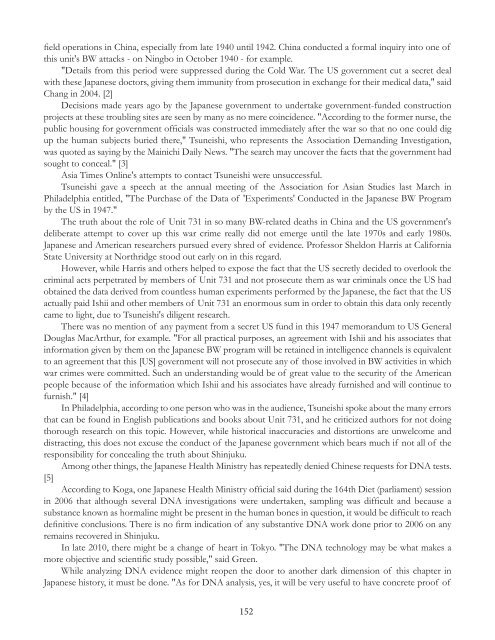Download - Canada ALPHA
Download - Canada ALPHA
Download - Canada ALPHA
Create successful ePaper yourself
Turn your PDF publications into a flip-book with our unique Google optimized e-Paper software.
fi eld operations in China, especially from late 1940 until 1942. China conducted a formal inquiry into one of<br />
this unit's BW attacks - on Ningbo in October 1940 - for example.<br />
"Details from this period were suppressed during the Cold War. The US government cut a secret deal<br />
with these Japanese doctors, giving them immunity from prosecution in exchange for their medical data," said<br />
Chang in 2004. [2]<br />
Decisions made years ago by the Japanese government to undertake government-funded construction<br />
projects at these troubling sites are seen by many as no mere coincidence. "According to the former nurse, the<br />
public housing for government offi cials was constructed immediately after the war so that no one could dig<br />
up the human subjects buried there," Tsuneishi, who represents the Association Demanding Investigation,<br />
was quoted as saying by the Mainichi Daily News. "The search may uncover the facts that the government had<br />
sought to conceal." [3]<br />
Asia Times Online's attempts to contact Tsuneishi were unsuccessful.<br />
Tsuneishi gave a speech at the annual meeting of the Association for Asian Studies last March in<br />
Philadelphia entitled, "The Purchase of the Data of 'Experiments' Conducted in the Japanese BW Program<br />
by the US in 1947."<br />
The truth about the role of Unit 731 in so many BW-related deaths in China and the US government's<br />
deliberate attempt to cover up this war crime really did not emerge until the late 1970s and early 1980s.<br />
Japanese and American researchers pursued every shred of evidence. Professor Sheldon Harris at California<br />
State University at Northridge stood out early on in this regard.<br />
However, while Harris and others helped to expose the fact that the US secretly decided to overlook the<br />
criminal acts perpetrated by members of Unit 731 and not prosecute them as war criminals once the US had<br />
obtained the data derived from countless human experiments performed by the Japanese, the fact that the US<br />
actually paid Ishii and other members of Unit 731 an enormous sum in order to obtain this data only recently<br />
came to light, due to Tsuneishi's diligent research.<br />
There was no mention of any payment from a secret US fund in this 1947 memorandum to US General<br />
Douglas MacArthur, for example. "For all practical purposes, an agreement with Ishii and his associates that<br />
information given by them on the Japanese BW program will be retained in intelligence channels is equivalent<br />
to an agreement that this [US] government will not prosecute any of those involved in BW activities in which<br />
war crimes were committed. Such an understanding would be of great value to the security of the American<br />
people because of the information which Ishii and his associates have already furnished and will continue to<br />
furnish." [4]<br />
In Philadelphia, according to one person who was in the audience, Tsuneishi spoke about the many errors<br />
that can be found in English publications and books about Unit 731, and he criticized authors for not doing<br />
thorough research on this topic. However, while historical inaccuracies and distortions are unwelcome and<br />
distracting, this does not excuse the conduct of the Japanese government which bears much if not all of the<br />
responsibility for concealing the truth about Shinjuku.<br />
Among other things, the Japanese Health Ministry has repeatedly denied Chinese requests for DNA tests.<br />
[5]<br />
According to Koga, one Japanese Health Ministry offi cial said during the 164th Diet (parliament) session<br />
in 2006 that although several DNA investigations were undertaken, sampling was diffi cult and because a<br />
substance known as hormaline might be present in the human bones in question, it would be diffi cult to reach<br />
defi nitive conclusions. There is no fi rm indication of any substantive DNA work done prior to 2006 on any<br />
remains recovered in Shinjuku.<br />
In late 2010, there might be a change of heart in Tokyo. "The DNA technology may be what makes a<br />
more objective and scientifi c study possible," said Green.<br />
While analyzing DNA evidence might reopen the door to another dark dimension of this chapter in<br />
Japanese history, it must be done. "As for DNA analysis, yes, it will be very useful to have concrete proof of<br />
152


